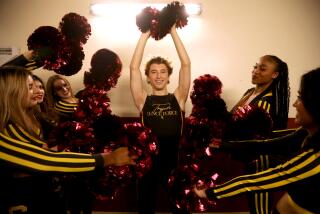Review: Paul Taylor proves staying power of ‘70s and ‘80s dance
Now 86, Paul Taylor has been making dances for more than 60 years. His artistic legacy far exceeds, and reverberates much wider, than the sum of his individual pieces.
In preparation for a future Paul Taylor Dance Company without the master, outside choreographers have been invited in to make works for Taylor’s exemplary dancers. Taking a different tack from the late Merce Cunningham, who decided his troupe would close after his death, Taylor’s will go forward.
When the New York-based group settled into the Wallis Annenberg Center for the Performing Arts this past weekend, however, the program focused on decades past: “Syzygy” from 1987; “The Word,” from 1998; and the still-fresh and always uplifting “Esplanade,” from 1975. One takeaway from all three was his masterful way with group movement, and how he uses it — in an unsurpassed way — as a force to express good and evil.
“Syzygy” is an astronomical term referring to celestial bodies at opposing points in an orbit, but consider this to be a prompt mostly, for a work of whirling athletic forcefulness. Taylor gives us a central female dancer — on Saturday night it was the frisky and musical Madelyn Ho — who seems to regulate a gravitational push and pull in which the others are caught.
Beyond that suggestion of an ongoing relationship, the dance, to a commissioned score by Donald York, overflows with messy, squiggly gestures of apparent randomness and increasing energy. Taylor clumps male and female dancers separately at first, but then these gender groupings splinter into smaller, mixed partnerships.
Dancers whiz through half-cartwheels and fling arms loosely outward. Bodies are as pliable as a slack rope. When Robert Kleinendorst lifts the petite Ho above his head, her knees bounce off one of his shoulders then the next. Dancers spin one-footed using centripetal force, and the piece concludes with Ho slowly rotating.
“The Word” is one of several Taylor pieces condemning religious group-think. This is the fierce and morose side of the choreographer, and the piece carries a stench of tribal violence, to an equally dark score by David Israel (all music was recorded).
Eleven grim-faced men and women pound heavily with their feet, fingers in white-knuckled fists. They are anonymously alike with slicked scalps, white faces and blackened eyes, dressed in short pants, ties and white shirts by designer Santo Loquasto. A scowling Parisa Khobdeh storms through the scenes as a demon temptress, clad in a unitard with reddened nipples, her hair flying.
Thanks to lighting designs by Jennifer Tipton, larger-than-life shadows on the backdrop trail the congregation. Fear and shame grip them. Jamie Rae Walker, one of the outstanding soloists, fearlessly throws herself backward, head to the floor, one virtuoso move in a night full of them.
The sun shines again in “Esplanade,” a piece of everyday walks, runs and breathtaking slides, to selections by J. S. Bach. Dancers reassuringly touch and carry one another. Taylor does inject sadness into a middle section — because darkness and light coexist in this choreographer’s works. But the final arms-open gesture of joyful greeting, warmly delivered by Michelle Fleet, allows the audience to exit with hope.
SIGN UP for the free Essential Arts & Culture newsletter »
Support coverage of SoCal arts. Share this article.
ALSO
‘In the Steps of Trisha Brown,’ and the L.A. festival where dance and film collide
Diary of a world premiere: Join playwright Rajiv Joseph as the curtain rises on his ‘Archduke’
A critic’s take on the Tony nominations: Kudos for rewarding shows that take risks
These teachers waited in line nearly 24 hours to be first for ‘Hamilton’ L.A. tickets
More to Read
The biggest entertainment stories
Get our big stories about Hollywood, film, television, music, arts, culture and more right in your inbox as soon as they publish.
You may occasionally receive promotional content from the Los Angeles Times.










